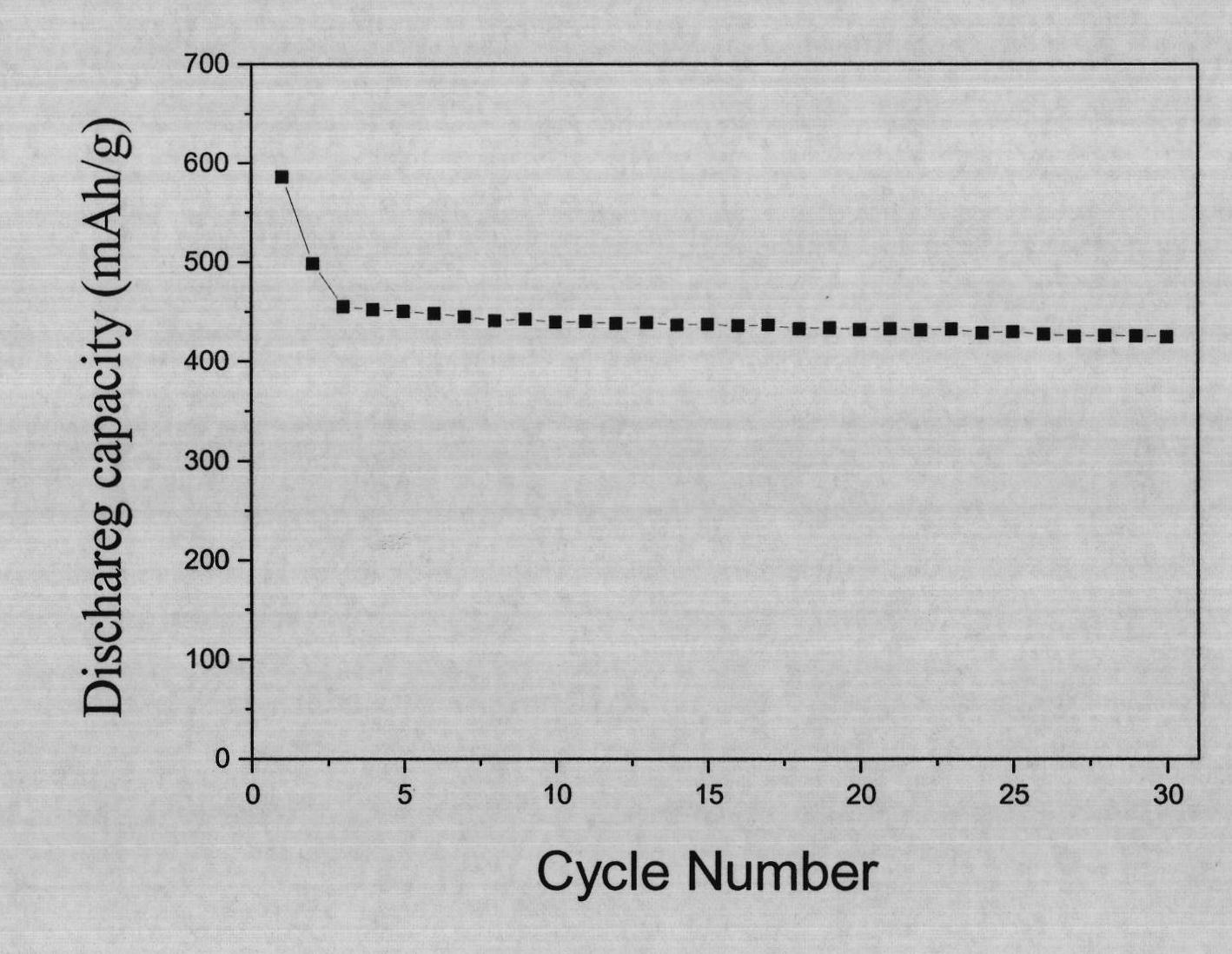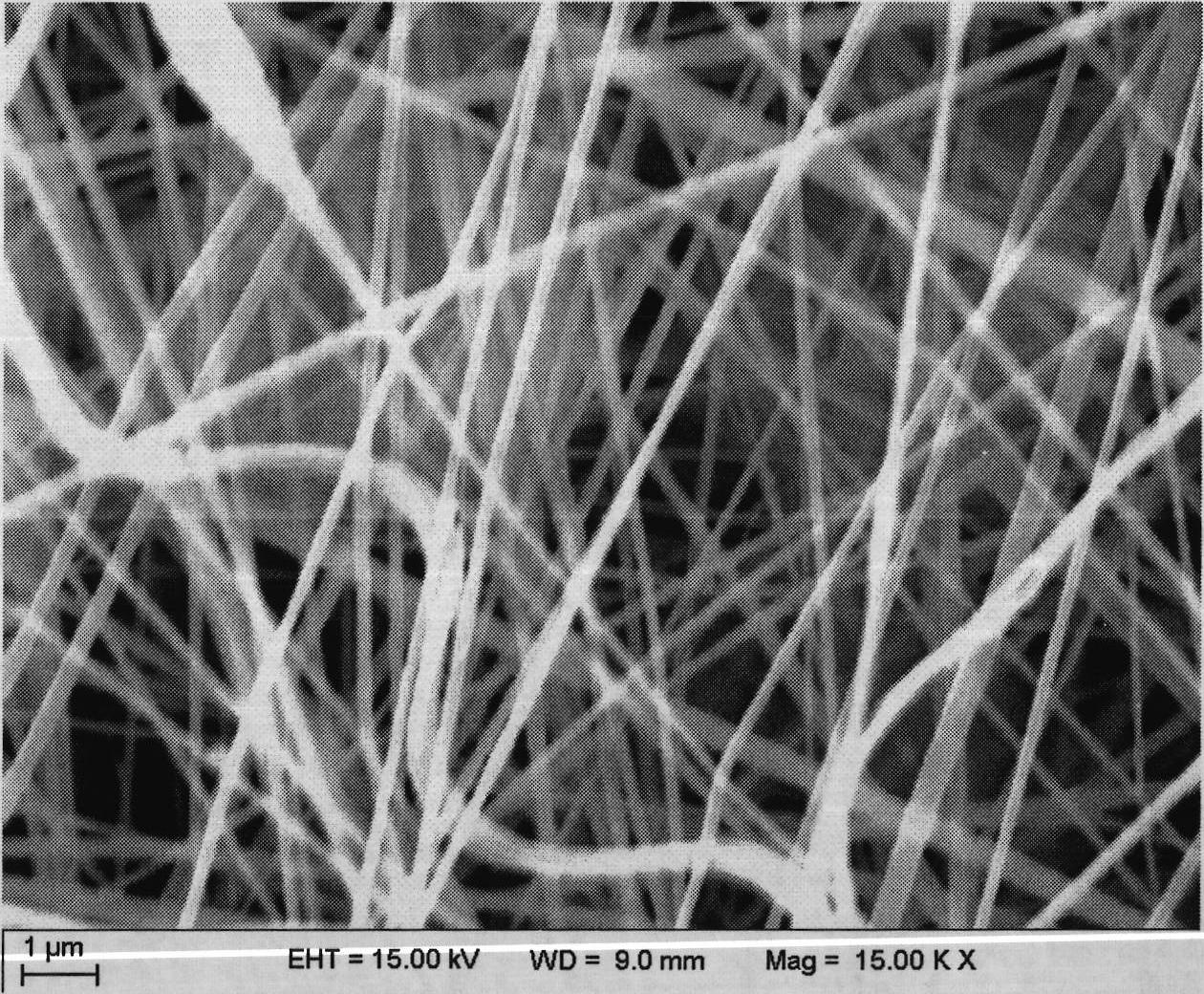Porous carbon nanofiber anode material for lithium ion battery and preparation method thereof
A technology of lithium-ion batteries and nanofibers, which is applied in the field of nanomaterials and chemical power sources, can solve the problems of low initial cycle efficiency, poor cycle stability, and poor rapid charge and discharge capabilities, achieve high initial discharge capacity and cycle stability, and improve Effect of high power characteristics, improvement of first-cycle efficiency and cycle stability
- Summary
- Abstract
- Description
- Claims
- Application Information
AI Technical Summary
Problems solved by technology
Method used
Image
Examples
Embodiment 1
[0019] Weigh PAN 1.8g, PMMA 0.2g (PAN / PMMA=9:1); PAN 1.4g, PMMA 0.6g (PAN / PMMA=7:3); PAN, PMMA each 1g (PAN / PMMA=5:5 ), and then added to three parts of 23ml DMF solution respectively, and stirred with a glass rod for about 20min until completely uniform swelling. Then the mixed solution was transferred to a 50ml Erlenmeyer flask, put into a magnetic rotor, adjusted to an appropriate rotational speed, and stirred at room temperature for 24 hours. The above-mentioned spinning solution prepared is put into self-made spinning equipment, under the process conditions of spinning voltage 10kV, collecting distance 8cm, solution extrusion speed 0.3ml / h, spinning for 10 hours, then drying in a vacuum oven for 2 hours, the PAN / PMMA nanofiber membrane was obtained. The above PAN / PMMA nanofiber membrane was transferred into a high-temperature tube furnace, heated from room temperature to 230 °C at a heating rate of 2 °C / min, and then pre-oxidized at 230 °C for 1 h. Pass inert gas N 2 P...
Embodiment 2
[0021] Weigh PAN 1.8g, PMMA 0.2g (PAN / PMMA=9:1); PAN 1.4g, PMMA 0.6g (PAN / PMMA=7:3); PAN, PMMA each 1g (PAN / PMMA=5:5 ), and then added to three parts of 23ml DMF solution respectively, and stirred with a glass rod for about 20min until completely uniform swelling. Then the mixed solution was transferred to a 50ml Erlenmeyer flask, put into a magnetic rotor, adjusted to an appropriate rotational speed, and stirred at room temperature for 24 hours. The above-mentioned spinning solution prepared is put into self-made spinning equipment, under the process conditions of spinning voltage 10kV, collecting distance 12cm, solution extrusion speed 0.5ml / h, spinning for 10 hours, then drying in a vacuum oven for 2 hours, the PAN / PMMA nanofiber membrane was obtained. The above PAN / PMMA nanofiber membrane was transferred into a high-temperature tube furnace, heated from room temperature to 250 °C at a heating rate of 2 °C / min, and then pre-oxidized at 250 °C for 1 h. Pass inert gas N 2 ...
Embodiment 3
[0023] Weigh PAN 1.8g, PMMA 0.2g (PAN / PMMA=9:1); PAN 1.4g, PMMA 0.6g (PAN / PMMA=7:3); PAN, PMMA each 1g (PAN / PMMA=5:5 ), and then added to three parts of 23ml DMF solution respectively, and stirred with a glass rod for about 20min until completely uniform swelling. Then the mixed solution was transferred to a 50ml Erlenmeyer flask, put into a magnetic rotor, adjusted to an appropriate rotational speed, and stirred at room temperature for 24 hours. The above-mentioned spinning solution prepared is put into self-made spinning equipment, under the process conditions of spinning voltage 12kV, collection distance 15cm, solution extrusion speed 1.0ml / h, spinning for 10 hours, then drying in a vacuum oven for 2 hours, the PAN / PMMA nanofiber membrane was obtained. The above PAN / PMMA nanofiber membrane was transferred into a high-temperature tube furnace, heated from room temperature to 250 °C at a heating rate of 2 °C / min, and then pre-oxidized at 250 °C for 1 h. Pass inert gas N 2 ...
PUM
 Login to View More
Login to View More Abstract
Description
Claims
Application Information
 Login to View More
Login to View More - R&D
- Intellectual Property
- Life Sciences
- Materials
- Tech Scout
- Unparalleled Data Quality
- Higher Quality Content
- 60% Fewer Hallucinations
Browse by: Latest US Patents, China's latest patents, Technical Efficacy Thesaurus, Application Domain, Technology Topic, Popular Technical Reports.
© 2025 PatSnap. All rights reserved.Legal|Privacy policy|Modern Slavery Act Transparency Statement|Sitemap|About US| Contact US: help@patsnap.com



